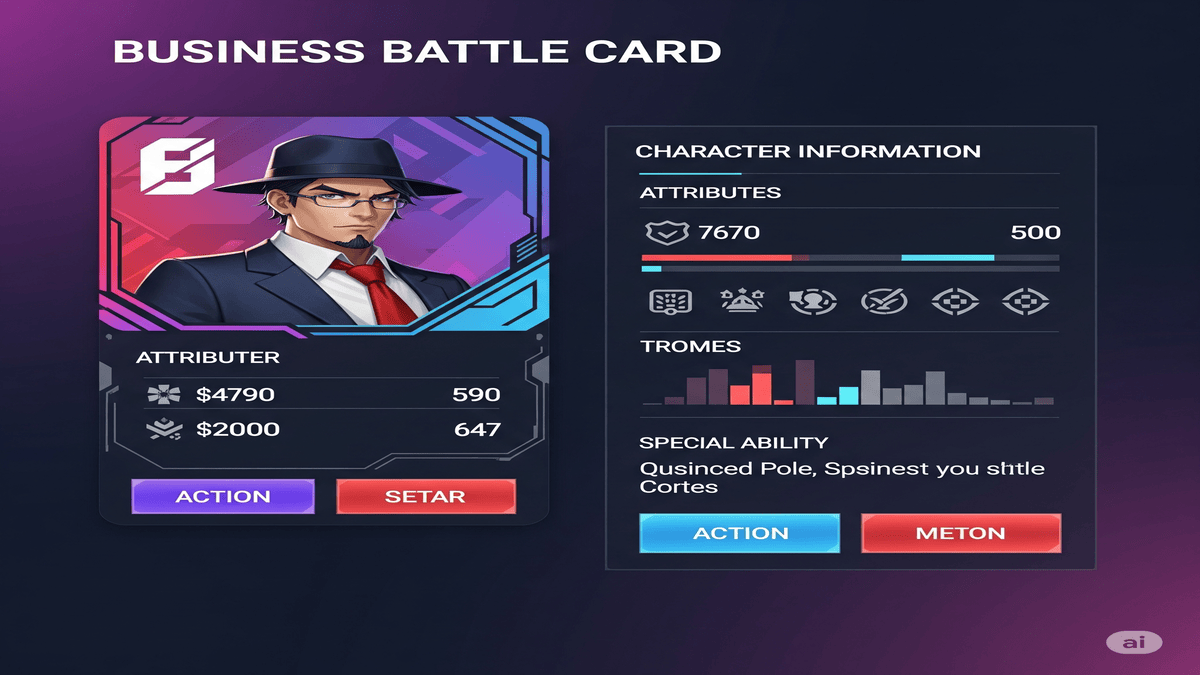In today’s fast-moving business environment, companies need to stay ahead of their competition by using strategic tools that simplify complex information. One such powerful tool is the Business Battle Card UI. Designed to provide quick insights and comparisons, this user interface format helps sales teams, marketers, and business strategists make smarter decisions in competitive scenarios.
What Is a Business Battle Card UI?
A Business Battle Card UI is a user interface that visually organizes key data points and competitive intelligence into a compact, easy-to-digest format. Traditionally used by sales teams, battle cards compare your company’s strengths, weaknesses, products, and strategies to those of your competitors. The UI version takes this a step further by presenting it digitally, often in dashboards or CRM systems.
This UI not only increases usability but also enhances decision-making by making real-time insights readily accessible. It’s like a cheat sheet, but designed for efficiency and smart execution in the business world.
Why Use a Business Battle Card UI?
Sales and marketing professionals often need to make fast decisions during pitches, presentations, or client discussions. A well-designed business battle card UI offers:
- Quick access to competitor data
- Consistent messaging across the team
- Improved win rates in sales
- Confidence in responses to objections
- Streamlined training for new employees
These cards empower teams with the right messaging at the right time, ensuring consistency and agility in competitive engagements.
Key Elements of a Business Battle Card UI
To make a Business Battle Card UI effective, it should include the following components:
- Competitor Overview: Company background, mission, market position.
- Product Comparison: Features, pricing, performance metrics.
- Strengths & Weaknesses: SWOT analysis side-by-side.
- Objection Handling: Common objections and effective responses.
- Differentiators: What makes your product or service unique.
- Sales Tips: Key talking points or conversation starters.
- Visual Cues: Icons, color-coding, and charts to improve readability.
These UI components need to be intuitive, mobile-friendly, and integrated into your team’s workflow to be truly effective.
How Does the UI Make a Difference?
The traditional battle card is often a PDF or printed sheet—useful, but static and outdated quickly. A Business Battle Card UI, on the other hand:
- Allows for real-time updates
- Can be customized for different industries or clients
- Integrates into CRM tools like Salesforce or HubSpot
- Provides interactive features like collapsible sections and hover tooltips
- Offers analytics tracking, so managers can see which data is most useful
This digital evolution helps businesses stay agile and informed.
Common Use Cases
- Sales Meetings: Reps can confidently address concerns and highlight differentiators.
- Internal Training: Onboarding new hires becomes faster with visual learning tools.
- Marketing Strategy: Teams align on brand positioning with up-to-date data.
- Customer Success Teams: Help retain clients by demonstrating value with comparisons.
Design Best Practices for Business Battle Card UIs
Creating an effective UI involves a balance between information and usability. Some top tips include:
- Keep the layout clean and minimal
- Use interactive tabs or accordions to avoid clutter
- Highlight key messages using bold fonts or color contrast
- Prioritize mobile responsiveness
- Use data visualization for product comparisons
The goal is to present dense competitive information in a way that’s accessible and engaging.
Benefits to Your Business
- Faster decision-making
- Stronger positioning in sales conversations
- Reduced training time
- Higher customer conversion rates
- Improved collaboration across departments
By investing in a Business Battle Card UI, companies gain a long-term strategic advantage that directly impacts revenue and market share.
Final Thoughts
The Business Battle Card UI isn’t just a nice-to-have—it’s a necessity for modern businesses that operate in competitive markets. Whether you’re pitching to clients, responding to objections, or training your salesforce, a clean and dynamic UI can be the key to success. It’s where strategy meets design to fuel business growth.
FAQs
Q1: Who should use a Business Battle Card UI?
A: Sales reps, marketing teams, product managers, and business strategists benefit most from using a battle card UI to stay competitive.
Q2: What tools can I use to build a Business Battle Card UI?
A: You can use platforms like Notion, Airtable, Salesforce, HubSpot, or custom UI frameworks using React or Figma for design.
Q3: How often should the content be updated?
A: Ideally, battle card content should be reviewed and updated monthly or whenever there are major product or market changes.
Q4: Can it be used by small businesses or startups?
A: Absolutely. Even small teams benefit from streamlined, consistent competitive messaging, especially when scaling sales efforts.
Q5: What’s the difference between a sales battle card and a business battle card UI?
A: A sales battle card is often static and focused on one product. A business battle card UI is interactive, broader in scope, and integrates with digital tools to support overall strategy.

 Blog2 months ago
Blog2 months ago
 education2 months ago
education2 months ago
 Blog2 weeks ago
Blog2 weeks ago
 News2 months ago
News2 months ago



















